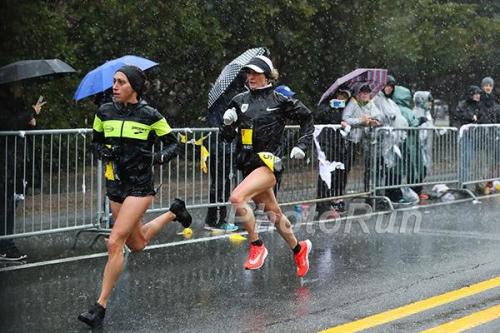Well, the running gods know that Boston marathon runners are a special breed. The weather was tough in 2018, and now, in 2019, deja vu all over again. This year, the wind and rain are back, but, the temperatures are the question. So, please be careful.
 Linden helps Flanagan, photo by PhotoRun.net
Linden helps Flanagan, photo by PhotoRun.net
As we know, New England weather can change from day to day. The Boston Athletic Association (B.A.A.) urges all participants to take personal responsibility and dress in layers for the 2019 Boston Marathon®.
Running in every type of weather presents its own challenges. Cold weather running is no exception. Below, the B.A.A. offers guidelines to help participants run efficiently, maintain a healthy body temperature, and keep yourself safe.
OVERALL TIPS
Dress for the Weather: Proper attire is vital to successful cold weather running. Wear the proper amount of clothing. Too little clothing is risky, while too much clothing is cumbersome.
Wear Your Bib On Your Outermost Layer: While running, please have your bib number on your outer- most layer and on the front of your torso. Your bib has important information printed on both sides and timing technology attached to it. It must be clearly displayed on the front of your torso during the race.
PRE-RACE
Dress in Layers: Dress in layers and avoid bulky outer clothing. The innermost layer should be thin, comfortable and fairly tight fitting. Several thin layers trap the warm air and keep us warmer than one thick cover. The outer layer should be waterproof and wind resistant. You must present your bib number to board the busses to Hopkinton, so please be prepared to make it visible.
Bring Extra Clothing: While you are in the Athletes’ Village in Hopkinton, warm sweatpants, a sweatshirt or jacket, along with a hat and waterproof gloves will make your wait warmer and more comfortable. Given the current conditions, the fields at the Athletes Village will be wet. You may decide to wear an older pair of running shoes, or plastic bags over your shoes, then discard them before heading to the start.
Bring a Clear Plastic Bag: Remember, if you are planning to bring a plastic bag that can be used as a poncho, please make sure it is clear to assist with normal security measures.
DURING THE RACE
Wear a Hat and Gloves: While running, keep using waterproof gloves and cover your head with a waterproof hat. Heat escapes through uncovered body parts – especially your head. Wearing long sleeves, waterproof gloves and a rain resistant hat can reduce heat loss.
Hydrate: In cold weather, it is easy to overlook your fluid needs. Your body is still sweating, so replenish your fluids appropriately. The rule of thumb during exercise is to drink when you feel thirsty and by taking no more than one cup (8 ounces) of fluid every 20 minutes. While racing in the cold, slow down a bit more than usual at drink stations to avoid spilling liquid on your gloves.
POST-RACE
Make an Exit Plan: Make an exit plan before race day with your family or support team. Having this exit plan is a must in preventing post-race hypothermia. The area around Copley Square and Boston Common can become windy and colder than what you may experience on the course – especially if there is a sea breeze.
Find a Warm Meeting Place: Once you have received your medal, water, and food, find a way to stay warm – a change of clothing and using the Boston Marathon HeatSheet product is a great start.
Support Your Team: Developing a post-race exit strategy is equally important for your support staff. They have been waiting for you to finish in the cold and rain, and will need to find a warm dry place as well. By taking this post-race approach you will help maintain your body core temperature and help prevent hypothermia.





















